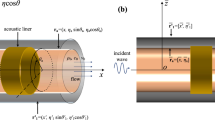Abstract
Curved and straight waveguides are ubiquitous in engineering structures. For modelling these structures in the mid-frequency and high-frequency range, the knowledge of the wave behaviour can be greatly beneficial. This paper addressed the modelling of such structures using the wave and finite element (WFE) method. In particular, power flow is formulated and investigated, and two numerical examples are presented to demonstrate how the method can be used to analyse structures that comprise straight and helical waveguides.
Access this chapter
Tax calculation will be finalised at checkout
Purchases are for personal use only
Similar content being viewed by others
References
Achenbach J (1984) Wave propagation in elastic solids. North Holland
Duhamel D, Mace BR, Brennan MJ (2006) Finite element analysis of the vibrations of waveguides and periodic structures. J Sound Vib 294(1–2):205–220
Lee J, Thompson DJ (2001) Dynamic stiffness formulation, free vibration and wave motion of helical springs. J Sound Vib 239
Lee SK (2006) Wave reflection, transmission and propagation in structural waveguides. Ph.D. thesis, University of Southampton
Lee SK, Mace BR, Brennan MJ (2007) Wave propagation, reflection and transmission in curved beams. J Sound Vib 306(3–5):636–656
Love AEM (1899) The propgation of waves of elastic displacement along a helical wire. Trans Cambridge Philos Soc 18:364–374
Mace BR (1984) Wave reflection and transmission in beams. J Sound Vib 72(2):237–246
Mace BR, Duhamel D, Brennan MJ, Hinke L (2005) Finite element prediction of wave motion in structural waveguides. J Acoust Soc Am 117(5):2835–2843
Manconi E, Sorokin S, Garziera R, Soe-Knudsen A (2018) Wave motion and stop-bands in pipes with helical characteristics using wave finite element analysis. J Appl Comput Mech 4:420–428
Mitrou G, Ferguson N, Renno J (2017) Wave transmission through two-dimensional structures by the hybrid FE/WFE approach. J Sound Vib 389:484–501
Mottershead JE (1980) Finite elements for dynamical analysis of helical rods. Int J Mech Sci 22(5):267–283
Renno J, Mace BR (2013) Calculation of reflection and transmission coefficients of joints using a hybrid finite element/wave and finite element approach. J Sound Vib 332(9):2149–2164
Renno J, Sassi S, Gowid S (2020) Wave propagation in double helical rods. Wave Motion 93
Renno J, Mace BR (2014) Vibration modelling of structural networks using a hybrid finite element/wave and finite element approach. Wave Motion 51(4):566–580
Renno J, Mace B (2012) Vibration modelling of helical springs with non-uniform ends. J Sound Vib 331(12):2809–2823
Sorokin SV (2009) Linear dynamics of elastic helical springs: asymptotic analysis of wave propagation. Proc R Soc Lond 465:1513–1537
Tanner G (2009) Dynamical energy analysis-determining wave energy distributions in vibro-acoustical structures in the high-frequency regime. J Sound Vib 320(4–5):1023–1038
Waki Y, Mace BR, Brennan MJ (2009) Numerical issues concerning the wave and finite element method for free and forced vibrations of waveguides. J Sound Vib 327(1–2):92–108
Walsh SJ, White RG (2000) Vibrational power transmission in curved beams. J Sound Vib 233(3):455–488
Wittrick WH (1966) On elastic wave propagation in helical springs. Int J Mech Sci 8(1):25–47
Wu CM, Lundberg B (1996) Reflection and transmission of the energy of harmonic elastic waves in a bent bar. J Sound Vib 190(4):645–659
Xiuchang H, Hongxing H, Wu W, Zhipeng D (2013) Research on wave mode conversion of curved beam structures by the wave approach. J Vib Acoust Trans ASME 135(VIB-11-1284)
Yildirim V (1996) Investigation of parameters affecting free vibration frequency of helical springs. Int J Numer Methods Eng 39(1):99–114
Zhong W, Williams F (1995) On the direct solution of wave propagation for repetitive structures. J Sound Vib 181(3):485–485
Author information
Authors and Affiliations
Corresponding author
Editor information
Editors and Affiliations
Appendix 1. Matrices of Analytical Eigenvalue Problem
Appendix 1. Matrices of Analytical Eigenvalue Problem
As per the notation of [16], we will use the following:
and \(\kappa \) is the shear coefficient. The matrices of Eq. (2) are scaled to the left and right with a diagonal matrix having a diagonal (1, 1, 1, 1/d, 1/d, 1/d):
and finally
Rights and permissions
Copyright information
© 2021 Springer Nature Singapore Pte Ltd.
About this paper
Cite this paper
Renno, J., Sassi, S., Paurobally, M.R. (2021). Modelling Wave Behaviour of Elastic Helical Waveguides. In: Sapountzakis, E.J., Banerjee, M., Biswas, P., Inan, E. (eds) Proceedings of the 14th International Conference on Vibration Problems. ICOVP 2019. Lecture Notes in Mechanical Engineering. Springer, Singapore. https://doi.org/10.1007/978-981-15-8049-9_56
Download citation
DOI: https://doi.org/10.1007/978-981-15-8049-9_56
Published:
Publisher Name: Springer, Singapore
Print ISBN: 978-981-15-8048-2
Online ISBN: 978-981-15-8049-9
eBook Packages: EngineeringEngineering (R0)




